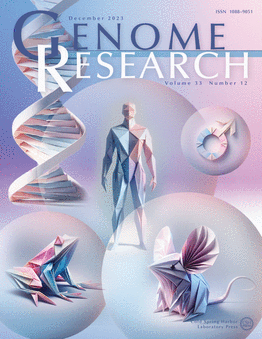Fusion, fission, and scrambling of the bilaterian genome in Bryozoa
IF 6.2
2区 生物学
Q1 BIOCHEMISTRY & MOLECULAR BIOLOGY
引用次数: 0
Abstract
Groups of orthologous genes are commonly found together on the same chromosome over vast evolutionary distances. This extensive physical gene linkage, known as macrosynteny, is seen between bilaterian phyla as divergent as Chordata, Echinodermata, Mollusca, and Nemertea. Here, we report a unique pattern of genome evolution in Bryozoa, an understudied phylum of colonial invertebrates. Using comparative genomics, we reconstruct the chromosomal evolutionary history of five bryozoans. Multiple ancient chromosome fusions followed by gene mixing led to the near-complete loss of bilaterian linkage groups in the ancestor of extant bryozoans. A second wave of rearrangements, including chromosome fission, then occurred independently in two bryozoan classes, further scrambling bryozoan genomes. We also discover at least five derived chromosomal fusion events shared between bryozoans and brachiopods, supporting the traditional but highly debated Lophophorata hypothesis and suggesting macrosynteny to be a potentially powerful source of phylogenetic information. Finally, we show that genome rearrangements led to the dispersion of genes from bryozoan Hox clusters onto multiple chromosomes. Our findings demonstrate that the canonical bilaterian genome structure has been lost across all studied representatives of an entire phylum, and reveal that linkage group fission can occur very frequently in specific lineages.苔藓虫中双边基因组的融合、裂变和混乱
在遥远的进化距离上,同源基因群通常在同一染色体上被发现。这种广泛的物理基因连锁,被称为大同步,在脊索动物、棘皮动物、软体动物和内默特亚动物等不同的双边门之间可见。在这里,我们报告了苔藓虫基因组进化的独特模式,这是一种未被充分研究的殖民地无脊椎动物门。利用比较基因组学,我们重建了5种苔藓虫的染色体进化史。多个古代染色体融合之后的基因混合导致现存苔藓虫祖先的双边连锁群几乎完全消失。第二波重排,包括染色体裂变,随后在两类苔藓虫中独立发生,进一步扰乱了苔藓虫的基因组。我们还发现在苔藓虫和腕足动物之间至少有5个衍生的染色体融合事件,这支持了传统的但备受争议的Lophophorata假说,并表明macrosynteny是一个潜在的强大的系统发育信息来源。最后,我们表明,基因组重排导致基因分散从苔藓虫Hox簇到多个染色体。我们的研究结果表明,在整个门的所有研究代表中,典型的双侧基因组结构已经丢失,并揭示了连锁群裂变在特定谱系中可能非常频繁地发生。
本文章由计算机程序翻译,如有差异,请以英文原文为准。
求助全文
约1分钟内获得全文
求助全文
来源期刊

Genome research
生物-生化与分子生物学
CiteScore
12.40
自引率
1.40%
发文量
140
审稿时长
6 months
期刊介绍:
Launched in 1995, Genome Research is an international, continuously published, peer-reviewed journal that focuses on research that provides novel insights into the genome biology of all organisms, including advances in genomic medicine.
Among the topics considered by the journal are genome structure and function, comparative genomics, molecular evolution, genome-scale quantitative and population genetics, proteomics, epigenomics, and systems biology. The journal also features exciting gene discoveries and reports of cutting-edge computational biology and high-throughput methodologies.
New data in these areas are published as research papers, or methods and resource reports that provide novel information on technologies or tools that will be of interest to a broad readership. Complete data sets are presented electronically on the journal''s web site where appropriate. The journal also provides Reviews, Perspectives, and Insight/Outlook articles, which present commentary on the latest advances published both here and elsewhere, placing such progress in its broader biological context.
 求助内容:
求助内容: 应助结果提醒方式:
应助结果提醒方式:


